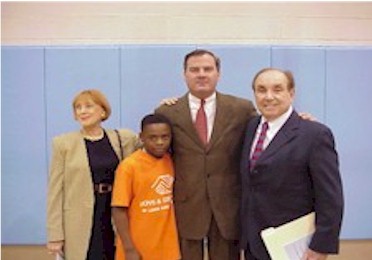
Lower Naugatuck Valley 2000
|
Bookmarks to sections of application |
|
| Application Home Page | Project Two |
| Community Background | Project Three |
| Civic Index | |
Project One - Boys & Girls Club

Breon Sanders Joins Governor Rowland,
Estelle and Ray Lavietes at the dedication.
1A. Briefly describe the first (Project One) of the three projects. Project one should have significantly impacted youth since 1997.
After eight years of operating out of make shift warehouses, abandoned garages, old lumber yards and facilities too small to provide adequate programs, the Boys and Girls Club opened a 30,000 square foot, $4,5 million facility on June 21, 1999. It was just a little more than eight years to the day that a tragic fire destroyed the old clubhouse in April of 1991, that the Board of Directors fulfilled its promise to again have a facility for the children of the community.
Consultants were hired and the process began to find a site and raise the funds to build a clubhouse for our children. The consultants said, "if we did a good job we might be able to raise $3 million," - a feat that had never been accomplished by any area non-profit. We raised $4.5 million. They said there was very little land available in the geographic area we needed to be, so we would have to move out of downtown. We purchased, and demolished a series of old contaminated factories, cleaned the sites and built our new clubhouse on a clean 2-acre parcel which used to be the most blighted property in town.
1B. What prompted the community to undertake this project?
The club was home to 972 children before the fire, many of whom would be called "at risk". Over 400 were teenagers, who needed a place to go after school. These teens had been referred by the Police, Boards of Education, or parents experiencing difficulty with parenting.
After the fire, the community faced numerous problems including high juvenile delinquency rates between 3 p.m. to 7 p.m., children getting poor grades in school, and families where both parents worked or children from single parent homes coming home to an unsupervised environment. The re-building of our clubhouse had to become reality.
1C. What significant impact has this project had on the community? Include quantifiable results as well as changes in the way the community confronts local issues.
Before the fire, we had average daily attendance of 235 children. As we bounced between temporary locations, membership dropped to 735 active members and less than 170 children per day. We had no athletic facilities so our teen membership dropped drastically, and there was little room for cultural or educational programs. We were a game room and place for kids to hang out. Very little developmental programming took place.
The new clubhouse opened on June 21, 1999. The first week we had 145 children enroll. The second week 274 more joined and by December 1400 joined the facility. A formal partnership with the Board of Education exists and we house the Alternative High School at our club from 7:30 a.m. to 2 p.m. Area schools send busloads of students to our clubhouse everyday. We have a fleet of three 15-passenger vans that transport children from the elementary schools in three towns to our club everyday. We average over 400 children per day. Our homework and computer rooms serve more than 50 children per hour, and the teens are back, with over 300 new teen members using our new 10,000 square foot gym or state-of-the-art weight lifting facility.
1D. What attempts were made to involve citizens and youth directly affected by the project in program development and to what extent were they successful? How were diverse segments of the population involved in the decision-making process? What general difficulties were encountered?
A safe place to go after school, with homework help, computers, a fun place that had games and sports activities. This was the rallying cry for the entire community, which helped raise the funds needed to build the new club.
PTA’s had penny drives, kids had car washes and parents had bake sales and candy sales, raising funds year after year. Canisters were placed throughout the Valley, with a "Coins for Kids" campaign that generated thousands. Area towns made financial contributions and the State of Connecticut provided almost a million dollars in bond funds. This was truly a partnership of the community, a non-profit in need and State & local governments coming together to help our children. Lawyers and engineers volunteered their time so we incurred no professional fees on the entire project. Our alumni association provided hundreds of hours of free skilled labor saving the club thousands.
1E. For Project One, list up to five principal groups and organizations involved. Briefly summarize their contribution to the project.
State & local government Expertise and aid in finance acquisition
Financial support of over $1 million
The Board of Directors (44 individuals) Organization, leadership, design and financial support of over $1 million
Board of Corporators Leadership, fundraising and financial
Support of over $400,000.
Pitney Bowes Corporation Contributed $175,000
Parents & youth groups Fund raisers, design development and motivation
1F. For Project One, identify three individuals who were active leaders. Include individuals from the public, private and non-project sectors.
Richard Belden State representative (800) 842-1423
Kenneth Nappi Shelton Director of Public Safety (203) 924-7389
Raymond P. Lavietes Retired (Shelton Products, Inc.) (203) 924-1871